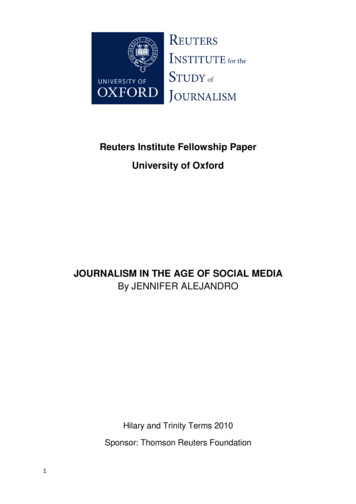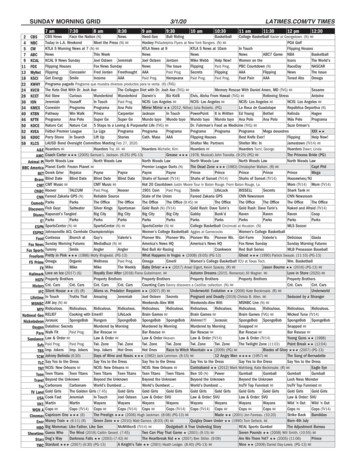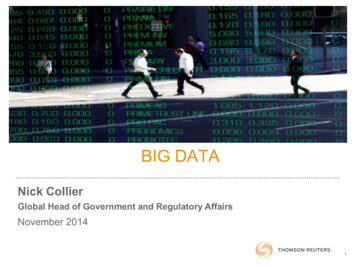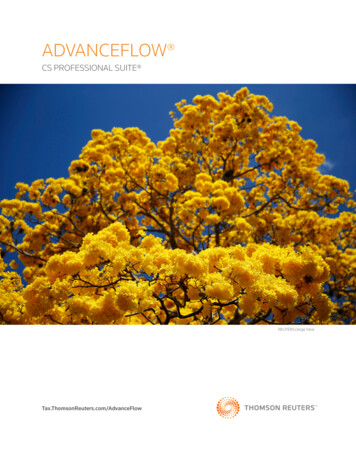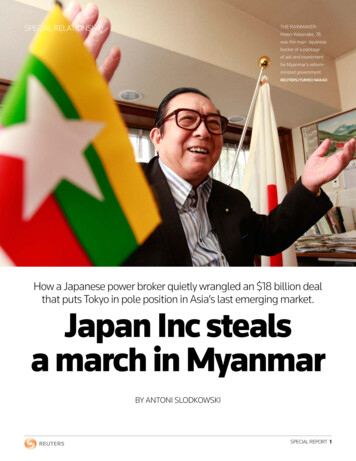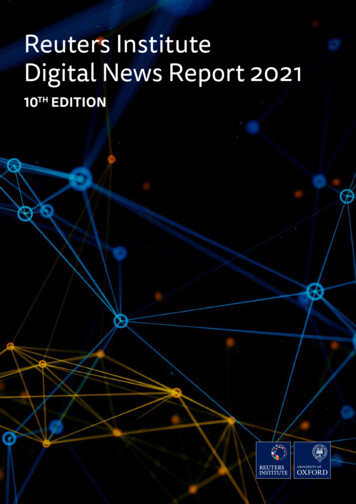
Transcription
Reuters InstituteDigital News Report 202110TH EDITION
Reuters InstituteDigital News Report 202110TH EDITIONNic Newman with Richard Fletcher, Anne Schulz,Simge Andı, Craig T. Robertson, and Rasmus Kleis NielsenSupported bySpanish translation supported bySurveyed by Reuters Institute for the Study of Journalism
Reuters Institute for the Study of Journalism/ Digital News Report 2021ContentsForeword by Rasmus Kleis Nielsen 53.17Poland 94Methodology 63.18Portugal 96Authorship and Research Acknowledgements 3.19Romania 987SECTION 1 Executive Summary and Key Findings by Nic Newman 9SECTION 2 Further Analysis and International Comparison 333.20 Slovakia 1003.21102Spain 3.22 Sweden 1043.23 Switzerland 1063.24 Turkey 108AMERICAS 2.1Perceptions of Fair News Coverageamong Different Groups 343.25 United States 1122.2Impartiality Unpacked: A Study of Four Countries 393.26 Argentina 1142.3Local News Unbundled:Where Audience Value Still Lies 3.27 Brazil 116433.28 Canada 1182.4How do People Think about the Financingof the Commercial News Media? 483.29 Chile 1202.5How and Why do Consumers Access Newson Social Media? 3.30 Colombia 122523.31124Mexico 3.32 Peru SECTION 3 Analysis by Country and Market 126ASIA PACIFIC 593.33 Australia 1303.34 Hong Kong 132623.35 India 1343.02 Austria 643.36 Indonesia 1363.03 Belgium 663.37 Japan 1383.04 Bulgaria 683.38 Malaysia 1403.05 Croatia 703.39 Philippines 1423.06 Czech Republic 723.40 Singapore 1443.07 Denmark 743.411463.08 Finland 763.42 Taiwan 1483.09 France 783.43 Thailand 1503.10Germany 80AFRICA 3.11Greece 823.44 Kenya 1543.12Hungary 843.45 Nigeria 1563.13Ireland 863.46 South Africa 1583.14Italy 883.15Netherlands 90SECTION 4 3.16Norway 92References and Selected Publications EUROPE 3.01United Kingdom South Korea 161
4/5ForewordProf. Rasmus Nielsen,Director, Reuters Institute for the Study of Journalism (RISJ)This is the tenth edition of our Digital News Report and a milestonefor us in that the 46 markets covered this year account for morethan half the world’s population. We are particularly proud tobe able to include more countries in the Global South, primarilybecause we hope the data and analysis we present are useful forjournalists, editors, and media executives there, but also becausewe strongly believe their colleagues elsewhere can learn a lotfrom the situation in countries where news media have long facedpolitical attacks, financial precarity, and internet users heavilyoriented towards mobile and social media – some of the realitiesjournalists in historically more privileged parts of the worldincreasingly have to deal with.Our findings this year show how, if anything, the Coronaviruspandemic has exacerbated many of the long-term trends we havedocumented over the past decade, especially the move to a moredigital, mobile, and platform-dominated media environment.Developments this year put further pressure on the businessmodels of many traditional media, but have also remindedat least parts of the public of the importance and value oftrustworthy news from independent news organisations.This year’s survey finds evidence that some brands have benefitedfrom a desire for reliable information around the pandemic –both in terms of higher reach, higher trust, and more payingsubscribers. While the effects are uneven, do not apply to allbrands or all countries, and may not last after the crisis is over,these are positive findings from publishers’ point of view.Our analysis also shows how the role of different platformsis evolving. We document the roles played by mainstreamnews organisations, individual journalists, and other voices ondifferent social media, the continuing move to closed messagingapps and more visual social media, as well as the continuedwidespread public concern over false or misleading information –especially Facebook and Facebook-owned messaging applicationsincluding WhatsApp.Amid deep divisions within many societies over politics and socialjustice, we ask searching questions about what people expectfrom their news and examine attitudes to traditional notions ofjournalistic impartiality and objectivity. We also explore how fairlythe media are seen as treating different groups including women,young people, and ethnic minorities.And our report continues to document the economic impact ofdigital disruption which has been intensified by the COVID-19pandemic (even as platform companies including Google andFacebook reported significant growth last year). Given thefinancial challenges the business of news faces, we explore publicattitudes to whether the government should step in to supportcommercial media – but find little appetite for this.Our survey this year covered 46 markets, including 24 in Europe,and six in Latin America where we have added Colombia andPeru. In Asia we have added India, Indonesia, and Thailand to ourexisting eight markets, and in Africa we are delighted to includeNigeria for the first time, following the inclusion of Kenya in 2020and South Africa in 2019.Because we use online polling, we continue to focus on countrieswith high internet penetration and which are either broadlydemocratic or generally compare themselves to countries witha democratic tradition. Even so, the increasing number anddiversity of markets covered have led us to compare fewer datapoints across the whole sample and to focus on meaningfulcomparisons across markets that are broadly similar. We’veprovided more detail about differences in polling samples in boththe methodology pages and the relevant country pages.This report continues to benefit from a strong network of partnersand sponsors around the world. We are proud to have theopportunity to work with a number of leading academics as wellas media experts from the news industry. Our partners have helpedin a variety of different ways, checking questionnaires, helpingwith interpretation, and often publishing their own reports.Given the richness of the research, this report can only convey asmall part of the data and analysis. More detail is available on ourwebsite https://www.digitalnewsreport.org/2021 which containsslidepacks and charts, along with a licence that encourages reuse,subject to attribution.Making all this possible, we are hugely grateful to our sponsors:the Google News Initiative, BBC News, Ofcom, the BroadcastingAuthority of Ireland, the Dutch Media Authority (CvdM), theMedia Industry Research Foundation of Finland, the Fritt OrdFoundation in Norway, the Korea Press Foundation, and EdelmanUK, as well as our academic sponsors at the Leibniz Institute forMedia Research/Hans Bredow Institute, Hamburg, the Universityof Navarra, the University of Canberra, the Centre d’études sur lesmédias, Quebec, Canada, and Roskilde University in Denmark.The Open Society Foundations has played a key role in helpingus to expand the report to cover more countries in the GlobalSouth over the last few years, as has Google’s commitment toa three-year extension of their support for the report. This yearFundación Gabo has joined the project, and we are delightedthey are supporting the translation of the report into Spanish.
Reuters Institute for the Study of Journalism/ Digital News Report 2021MethodologyThis study has been commissioned by the Reuters Institutefor the Study of Journalism to understand how news is beingconsumed in a range of countries. Research was conducted byYouGov (and their partners) using an online questionnaire atthe end of January/beginning of February 2021. Samples were assembled using nationally representative quotasfor age, gender, region in every market, and education in all marketsexcept Bulgaria, Croatia, Greece, India, Indonesia, Kenya, Malaysia,Mexico, Nigeria, Philippines, Romania, South Africa, Thailand, andTurkey. In the US, UK, Denmark, Sweden, Norway, and Italy we haveapplied additional political quotas based on vote choice in the mostrecent national election. The data in all markets were also weightedto targets based on census/industry-accepted data. Data from India, Kenya, Nigeria, and South Africa are representativeof younger English-speakers and not the national population,because it is not possible to reach other groups in a representativeway using an online survey. The survey was fielded in English inthese markets,1 and restricted to ages 18–50 in Kenya and Nigeria.Findings should not be taken to be nationally representative inthese countries. These differences mean we need to be cautious whencomparing results between markets, especially on issueswhere we know that the sample would potentially make asignificant difference (e.g. paying for news or podcasts). It is also important to note that online surveys rely on recall,which is often imperfect or subject to biases. We have tried tomitigate these risks through careful questionnaire design andtesting. Despite other limitations, surveys are able to capturemedia consumption across platforms, including social media,messaging apps, and websites. They are also a good way oftracking activities and changes over time in a consistent way.2 It is important to note that some of our survey-based resultswill not match industry data, which are often based ondifferent methodologies, such as web-tracking. The accuracyof these approaches can be high, but they are also subject tolimitations. In some cases, we have drawn on data from other surveys orfrom industry sources and have signalled this in the text oras a footnote. We have also used selected quotes from focusgroups and interviews conducted in four countries (USA, UK,Germany, and Brazil) in February 2021. On occasion we havealso used quotes from open questions from our main survey,clearly indicating this in each case. More generally, online samples will tend to under-representthe news consumption habits of people who are older and lessaffluent, meaning online use is typically over-represented andtraditional offline use under-represented. In this sense, it is better A fuller description of the methodology, panel partners, andto think of results as representative of the online population.a discussion of non-probability sampling techniques canIn markets in Northern and Western Europe, where internetbe found on our website along with the full questionnairepenetration is typically around 95%, the differences between REUTERSFORTHEnationalSTUDY OFJOURNALISM/ populationwillbe small, butinSouth Africa (58%) and India (54%), where internet penetrationis lower, the differences between the online population and thenational population will be large.Slide m95%PolandPortugal2,00938m78%Asia mania2,01019m74%Hong en2,005Czech es2,029111m78%Singapore2,0345.9m88%96%South %Mexico2,036131m65%South Source: Internet World Stats (http://www.internetworldstats.com).In the Netherlands we conducted a repoll of brand reach numbers in late March 2021 due to a scripting error in the original poll. All other numbers are taken from the January/February poll.12Respondents in India could choose to complete the survey in Hindi and respondents in Kenya could chose Swahili, but in both cases the vast majority selected an English survey.From 2012 to 2020 we filtered out respondents who said that they had not consumed any news in the past month. From 2021 we included this group, which generally has lower interestin news. In previous years this group averaged around 2–3% of the starting sample in each market, meaning that the decision to include it has not affected comparative results in anysignificant way. Some figures have been affected by one or two points in the UK, USA, and Australia, and we have taken this into account when interpreting year-on-year change.
6Authorship and ResearchAcknowledgementsNic Newman is a Senior Research Associate at the Reuters Institute forthe Study of Journalism and is also a consultant on digital media, workingactively with news companies on product, audience, and businessstrategies for digital transition. He writes an annual report for theInstitute on future media and technology trends.Dr Richard Fletcher is a Senior Research Fellow at the Reuters Institutefor the Study of Journalism and leads the research team. He is primarilyinterested in global trends in digital news consumption, the use of socialmedia by journalists and news organisations, and more broadly, therelationship between computer-based technologies and journalism.Dr Anne Schulz is a postdoctoral Research Fellow at the Reuters Institutefor the Study of Journalism. She is researching questions surroundingnews audiences and digital news with a focus on local news, social media,news literacy, and trust. Her research is anchored in the fields ofjournalism studies, political communication, and media psychology.Dr Simge Andı is a postdoctoral Research Fellow at the ReutersInstitute for the Study of Journalism. Her doctoral work explored onlinemisinformation, mainly focusing on the sharing of false information viasocial media. She uses survey and experimental data to study theconsumption and sharing of news.Dr Craig T. Robertson is a postdoctoral Research Fellow at the ReutersInstitute for the Study of Journalism whose interests include news trustand credibility, fact-checking and verification, and how both partisanattitudes and epistemic beliefs factor into these domains.Prof. Rasmus Kleis Nielsen is Director of the Reuters Institute forthe Study of Journalism, Professor of Political Communication at theUniversity of Oxford, and served as Editor-in-Chief of the InternationalJournal of Press/Politics from 2015 to 2018. His work focuses on changesin the news media, political communication, and the role of digitaltechnologies in both.Market-level commentary and additional insight around media developmentshave been provided by academic partners and by our network of ReutersJournalist Fellows around the world.3 RISJ Senior Research Associate Dr DavidLevy did invaluable work editing and developing many of the country profilesin this year’s report. Additional expert analysis and interpretation of the surveydata were provided by the team at YouGov, in particular, Charlotte Clifford,Lucie Larboulette, David Eastbury, Mark Pellatt, and Kulvir Channa.3Reuters Fellowships offer an opportunity to mid-career journalists to spend time researching an aspect of journalism for one or more terms at the Institute in Oxford./7
Reuters Institute for the Study of Journalism/ Digital News Report 2021
8S E C T I O N1Executive Summaryand Key FindingsNic NewmanSenior Research Associate,Reuters Institute for the Study of Journalism/9
Reuters Institute for the Study of Journalism/ Digital News Report 2021More than a year after it began, the Coronaviruspandemic continues to cast a dark cloud over thehealth of our communities – as well as that ofthe news industry. The crisis – complete withlockdowns and other restrictions – has hastenedthe demise of printed newspapers, furtherimpacting the bottom line for many once proudand independent media companies. Our countrypages this year are full of stories of journalisticlay-offs as advertisers take fright in the face of aglobal economic downturn. New business modelssuch as subscription and membership have beenaccelerated by the crisis, as we document in thisyear’s report. But in most cases, this has stillnot come anywhere near making up for lostincome elsewhere.And yet this crisis has also shown the value of accurate andreliable information at a time when lives are at stake. In manycountries we see audiences turning to trusted brands – inaddition to ascribing a greater confidence in the media ingeneral. The gap between the ‘best and the rest’ has grown, ashas the trust gap between the news media and social media.Of course, these trends are not universal and this year’s reportalso exposes worrying inequalities in both consumption andtrust with the young, women, people from ethnic minorities,and political partisans often feeling less fairly representedby the media.The Capitol Hill riot in the United States and the global spreadof false information and conspiracy theories about Coronavirushave further focused minds on where people are getting theirnews, which is why we have undertaken detailed research thisyear on understanding the role of different social networks fornews and the complex ways in which they are being used tospread misleading and false information around the world.This tenth edition of our Digital News Report, based on datafrom six continents and 46 markets, aims to cast light on thekey issues that face the industry at a time of deep uncertaintyand rapid change. Our more global sample, which includesIndia, Indonesia, Thailand, Nigeria, Colombia, and Peru for thefirst time, provides a deeper understanding of how differentlythe news environment operates outside the United Statesand Europe and we have tried to find new ways to reflect this,whilst recognising that differences in internet penetration andeducation will make some comparisons less meaningful. Theoverall story is captured in this Executive Summary, followed bySection 2 with chapters containing additional analysis and thenindividual country and market pages in Section 3 with extra dataand industry context.A SUMMARY OF SOME OF THE MOST IMPORTANTFINDINGS FROM OUR 2021 RESEARCH Trust in the news has grown, on average, by six percentagepoints in the wake of the Coronavirus pandemic with 44% of ourtotal sample saying they trust most news most of the time. Thisreverses, to some extent, recent falls in average trust bringinglevels back to those of 2018. Finland remains the country withthe highest levels of overall trust (65%), and the USA now hasthe lowest levels (29%) in our survey. At the same time, trust in news from search and social hasremained broadly stable. This means that the trust gapbetween the news in general and that found in aggregatedenvironments has grown with audiences seemingly placinga greater premium on accurate and reliable news sources. In a number of countries, especially those with strong andindependent public service media, we have seen greaterconsumption of trusted news brands. The pattern is less clearoutside Western Europe, in countries where the Coronaviruscrisis has dominated the media agenda less, or where otherpolitical and social issues have played a bigger role. Television news has continued to perform strongly in somecountries, but print newspapers have seen a further sharpdecline almost everywhere as lockdowns impacted physicaldistribution, accelerating the shift towards a mostlydigital future. While many remain very engaged, we find signs that othersare turning away from the news media and in some casesavoiding news altogether. Interest in news has fallen sharplyin the United States following the election of President Biden– especially with right-leaning groups. Elsewhere, we find that the media are seen to be representingyoung people (especially young women), political partisans,and – at least in the US – people from minority ethnic groupsless fairly. These findings will give added urgency to those whoare arguing for more diverse and inclusive newsrooms. Despite more options to read and watch partisan news, themajority of our respondents (74%) say they still prefer newsthat reflects a range of views and lets them decide what tothink. Most also think that news outlets should try to beneutral on every issue (66%), though some younger groupsthink that ‘impartiality’ may not be appropriate or desirablein some cases, for example, on social justice issues. The use of social media for news remains strong, especiallywith younger people and those with lower levels of education.Messaging apps like WhatsApp and Telegram have becomeespecially popular in the Global South, creating most concernwhen it comes to spreading misinformation about Coronavirus. Global concerns about false and misleading information haveedged slightly higher this year, ranging from 82% in Brazil tojust 37% in Germany. Those who use social media are morelikely to say they have been exposed to misinformation aboutCoronavirus than non-users. Facebook is seen as the mainchannel for spreading false information almost everywherebut messaging apps like WhatsApp are seen as a bigger problemin parts of the Global South such as Brazil and Indonesia.
10 Our data suggest that mainstream news brands andjournalists attract most attention around news in bothFacebook and Twitter but are eclipsed by influencers andalternative sources in networks like TikTok, Snapchat, andInstagram. TikTok now reaches a quarter (24%) of under35s, with 7% using the platform for news – and a higherpenetration in parts of Latin America and Asia.We have seen significant increases in payment for onlinenews in a small number of richer Western countries, but theoverall percentage of people paying for online news remainslow. Across 20 countries where publishers have been pushingfor more online payment, 17% have paid for any online newsin the last year – up two percentage points. Norway continuesto lead the way with 45% ( 3) followed by Sweden (30%),the United States (21%), Finland (20%), the Netherlands(17%), and Switzerland (17%). There has been less progress inFrance (11%), Germany (9%), and the United Kingdom (8%).In most countries a large proportion of digital subscriptionsgo to just a few big national brands, reinforcing the winnertakes most dynamics that we have reported in the past. Butin the United States and Norway we do find that up to halfof those paying are now taking out additional subscriptions,often to local or regional newspaper brands.More widely, though, we find that the value of traditionallocal and regional news media is increasingly confined to asmall number of subjects such as local politics and crime.Other internet sites and search engines are considered bestfor a range of other local information including weather,housing, jobs, and ‘things to do’ that used to be part of whatlocal news media bundled together.Access to news continues to become more distributed. Acrossall markets, just a quarter (25%) prefer to start their newsjourneys with a website or app. Those aged 18–24 (so-calledGeneration Z) have an even weaker connection with websitesand apps and are almost twice as likely to prefer to accessnews via social media, aggregators, or mobile alerts.While mobile aggregators play a relatively small part in themedia eco-system of Western countries, they have a powerfulposition in many Asian markets. In India, Indonesia, SouthKorea, and Thailand a range of human- and AI-poweredapps like Daily Hunt, Smart News, Naver, and Line Today areplaying an important new role in news discovery.More widely, the use of smartphone for news (73%) hasgrown at its fastest rate for many years, with dependencealso growing through Coronavirus lockdowns. Use of laptopand desktop computers and tablets for news is stable orfalling, while the penetration of smart speakers remainslimited in most countries – especially for news.Growth in podcasts has slowed, in part due to the impact ofrestrictions on movement. This is despite some high-profilenews launches and more investment via tech platforms. Ourdata show Spotify continuing to gain ground over Apple andGoogle podcasts in a number of countries and YouTube alsobenefiting from the popularity of video-based and hybridpodcasts./11CHANGING NEWS CONSUMPTION AND THEIMPACT OF CORONAVIRUSThe pandemic has affected markets at different times and todifferent degrees. Our polling was conducted when the UK andIreland were in full lockdown, the United States and Brazil wereoperating under state-by-state rules, while Australia, Taiwan, andJapan were mostly free of internal restrictions. Common patternsmay be hard to discern, but it is instructive to look at parts ofthe world that have been badly and collectively affected. In thisrespect, Western Europe provides a good case study.Across a number of European countries we find that consumptionof television news is significantly higher than a year ago when no100%restrictions on movement were in place. This is not surprising,given that so many people have been stuck at home, but hasreaffirmed the importance of a medium that is accessible, easy toconsume, reaches a wide range of demographics, and is mostlywell trusted. Twenty-four-hour news channels such as Sky News75%percentage points) in the UK and n-tv ( 6pp) in Germany are( 5amongst the brands to have benefited.I was watching the press conferences on n-tv almostevery lunchtime. And, okay the Corona thing has calmedREUTERS INSTITUTE FOR THE STUDY OF JOURNALISM / EXECUTIVE SUMMARY GRAPHSdown a bit, but just being in my home-office means you50%2013 2014 2015 2016 2017 2018 2019 2020 2021Slide2 opportunities to have a quick look.have moreDNSIrFGUF, 56, Germany focus groupPROPORTION THAT USED TV NEWS IN THE LAST WEEK(2013-21) – SELECTED MARKETSUK100%Germany85%84%82%75% s69%68% 68%67%64%63%60%DNSIrF25%0%GU2013 2014 2015 2016 2017 2018 2019 2020 2021Q3. Which, if any, of the following have you used in the last week as a source of news? Base:Total 2013–21 samples in each market (most n 2000). Note: No data for 2014 due to a scriptingerror in the survey.In some of these countries, there has been an even bigger switchin underlying preference (main source) towards TV and away fromonline. In the UK, the proportion selecting TV news as main sourcewas up to 36% ( 7pp) and in Ireland 41% ( 8pp). In both countries wesee increased TV reliance across age groups, though older people, ofcourse, still have a much greater underlying preference for TV news.It would be wrong to over-emphasise any temporary bumpin TV consumption given the longer term shift towards digitalsources but it is a reminder of the continuing draw of video-basedstorytelling as well as the strength of traditional news brands. Butperhaps the most striking finding around consumption has beenthe extent to which people have placed a premium on reliablenews sources in general, not just on TV.
Reuters Institute for the Study of Journalism/ Digital News Report 2021Trusted brands also do better onlineIt is important to note that our last survey captured a momentin time pre-pandemic (January 2020), and a year later in January2021 we captured another, when the impact of Coronavirusvaried across countries. In the intervening time we know thatmost news brands reported at various times vastly increasedusage – especially during the first months of the crisis. Our data,a year on, perhaps show which brands may have held onto thosegains most effectively, giving a hint of more lasting changes.REUTERS INSTITUTE FOR THE STUDY OF JOURNALISM / EXECUTIVE SUMMARY GRAPHSSlide 4PROPORTION THAT USED SELECTED PSBs ONLINE IN THELAST WEEKIn our analysis of fourteen European countries (listed underneaththe chart below), we note that some of the most trusted newsorganisations – including commercial and public media brands –have retained quite significant extra online audiences in termsof online reach. On average, brands with lower trust scores havedone less well by comparison. This trend is strongest in Sweden,Austria, Ireland, and Norway, a little less so in Finland – perhapsbecause all big brands are relatively well trusted there.Looking across our data, although the overall link between trustand increased reach is weak, the key beneficiaries in terms ofweekly use seem to be big commercial and public service newsbrands – especially those that already had a reputation for reliableonline news. This means brands like VG in Norway ( 9pp), TV2in Denmark ( 8pp), and MTV News ( 7pp) in Finland. Othersthat have done better than average include The Irish Times ( 7pp),Der Standard in Austria ( 5pp), and Le Soir in Belgium ( 4pp).Many of these changes have come in markets where the overallconsumption of online news has not increased overall year-on-year.Onlinereach2020-2021changeNRK News (Norway)42% 8YLE (Finland)44% 5SVT (Sweden)34% 3RTÉ News (Ireland)41% 8BBC News (UK)46% 128% 3Average of 18 PSBs across 14 countriesQ5b. Which of the following brands have you used to access news online in the last week (viawebsites, apps, social media, and other forms of internet access)? Base: Total samples 2020-21samples in each market (n 2000).These gains have not been generally reflected in countrieswhere public broadcasters are less well trusted. Outside Europewe also find examples of PSBs that have enhanced their reachduring this crisis, including ABC in Australia. This has givena boost to a sector whose legitimacy and funding have beenthreatened by a combination of changing consumer behaviourand attacks by populist and right-wing politicians. Before thePublic service media websites have performed particularly well,crisis, for example, Boris Johnson’s Conservative governmentperhaps because they have been able to use their reach via TVin the UK was considering turning the BBC into a subscriptionREUTERSINSTITUTEFOR THEST
Prof. Rasmus Nielsen, Director, Reuters Institute for the Study of Journalism (RISJ) This is the tenth edition of our Digital News Report and a milestone for us in that the 46 markets covered this year account for more




